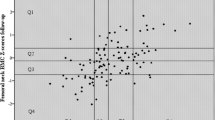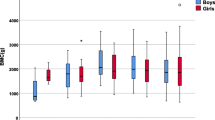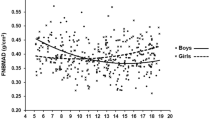Abstract
Background
The aim of this study was to provide normative data of bone mineral density (BMD; g/cm2) of the forearm and the calcaneus, evaluated by peripheral dual X ray absorbtiometry (DXA), in children aged 6 to 7 years of age and to evaluate the association with anthropometrics and sex.
Material and methods
368 boys and 326 girls with a mean age of 6.7 ± 0.4 years participated. BMD was measured by DXA in the forearms and the os calcanei, with average values presented in this report. Measurements of weight, height, skinfolds, the width of distal radius and ulna, and the femur condyles were collected and body composition estimated from skinfolds measurements.
Results
There was no difference in calcaneus BMD when comparing boys and girls, whereas the boys had 4.5% (0.013 g/cm2) higher forearm BMD than the girls (P < 0.001). Calcaneal BMD (mean 0.318 g/cm2) was 11% higher than forearm BMD (mean 0.283 g/cm2). Linear relationship was found between calcaneus BMD and weight (partial r = 0.50), Fat free mass (FFM) (partial r = 0.50), Fat mass (FM) (partial r = 0.45), % body fat (partial r = 0.29) and knee width (partial r = 0.46), all P < 0.000 respectively. Adjusted for weight the relationship between calcaneus BMD and FFM, FM, %body fat and knee width disappeared. There were significant relationships between the forearm BMD and weight (partial r = 0.37), FFM (partial r = 0.39), FM (partial r = 0.28), %body fat (partial r = 0.14) and wrist width (partial r = 0.24), all P < 0.000 respectively. Adjusted for body weight, the relationship remained between forearm BMD and FFM (r = 0.10), FM (R = −0.10) and % body fat (r = −0.12), all P < 0.000 respectively. Children measured in the spring had 3.5% (P < 0.01) higher calcaneus BMD than children measured in the winter.
Conclusion
Seven year old boys have higher BMD in the forearm but not in the calcaneus in comparison with girls of a similar age. Body weight is the best predictor of calcaneus BMD, accounting for 25% of the variance whereas body weight and FFM are the best predictors of forearm BMD, each accounting for 17% of the variance, respectively.



Similar content being viewed by others
References
Kelly PJ, Morrison NA, Sambrook PN, Nguyen TV, Eisman JA (1995) Genetic influences on bone turnover, bone density and fracture. Eur J Endocrinol 133:265–271
Specker BL (2001) The significance of high bone density in children. J Pediatr 139:473–475
Molgaard C, Thomsen BL, Michaelsen KF (1998) Influence of weight, age and puberty on bone size and bone mineral content in healthy children and adolescents. Acta Paediatr 87:494–499
Molgaard C, Thomsen BL, Michaelsen KF (1999) Whole body bone mineral accretion in healthy children and adolescents. Arch Dis Child 81:10–15
Duan Y, Parfitt A, Seeman E (1999) Vertebral bone mass, size, and volumetric density in women with spinal fractures. J Bone Miner Res 14:1796–1802
Malina RM, Bouchard C (2004) Growth, Matruation and Physical Activity. Human Kinetics, Champaign
Rubin CT, Lanyon LE (1984) Regulation of bone formation by applied dynamic loads. J Bone Joint Surg Am 66:397–402
Kannus P, Haapasalo H, Sankelo M, Sievanen H, Pasanen M, Heinonen A, Oja P, Vuori I (1995) Effect of starting age of physical activity on bone mass in the dominant arm of tennis and squash players. Ann Intern Med 123:27–31
Lanyon LE, Rubin CT (1984) Static vs dynamic loads as an influence on bone remodelling. J Biomech 17:897–905
Khan K, McKay HA, Kannus P, Bailey DA, Wark JD, Bennell KL (2001) Physical activity and bone health. Human Kinetics, Champaign
Sundberg M, Gardsell P, Johnell O, Karlsson MK, Ornstein E, Sandstedt B, Sernbo I (2002) Physical activity increases bone size in prepubertal boys and bone mass in prepubertal girls: a combined cross-sectional and 3-year longitudinal study. Calcif Tissue Int 71:406–415
Sowers M, Kshirsagar A, Crutchfield M, Updike S (1991) Body composition, age and femoral bone mass of young adult women. Ann Epidemiol 1:245–254
Lindsay R, Cosman F, Herrington BS, Himmelstein S (1992) Bone mass and body composition in normal women. J Bone Miner Res 7:55–63
Wardlaw GM (1993) Putting osteoporosis in perspective. J Am Diet Assoc 93:1000–1006
Ensrud KE, Lipschutz RC, Cauley JA, Seeley D, Nevitt MC, Scott J, Orwoll ES, Genant HK, Cummings SR (1997) Body size and hip fracture risk in older women: a prospective study. Study of Osteoporotic Fractures Research Group. Am J Med 103:274–280
Wegner M, Snow-Harder C, Robinson T, Shaw J, Shelley A (1993) Lean mass, not fat mass, independently predicts whole body mineral density in postmenopausal women. Med Sci Sports Exerc 25:S854
Aloia JF, McGowan DM, Vaswani AN, Ross P, Cohen SH (1991) Relationship of menopause to skeletal and muscle mass. Am J Clin Nutr 53:1378–1383
Reid IR, Plank LD, Evans MC (1992) Fat mass is an important determinant of whole body bone density in premenopausal women but not in men. J Clin Endocrinol Metab 75:779–782
Pocock N, Eisman J, Gwinn T, Sambrook P, Kelly P, Freund J, Yeates M (1989) Muscle strength, physical fitness, and weight but not age predict femoral neck bone mass. J Bone Miner Res 4:441–446
Snow-Harder C, Bouxsein M, Lewis BT, Charette S, Weinstein P, Marcus R (1990) Muscle strength as a predictor of bone mineral density in young women. J Bone Miner Res 5:589–595
Wang MC, Bachrach LK, Loan MV, Hudes M, Flegal KM, and Crawford PB (2005) The relative contributions of lean tissue mass and fat mass to bone density in young women. Bone 37, 474–481. Ref Type: Journal (Full)
Turner RT, Riggs BL, Spelsberg TC (1994) Skeletal effects of estrogen. Endocr Rev 15:275–300
Binkley TL, Specker BL, Wittig TA (2002) Centile curves for bone densitometry measurements in healthy males and females ages 5–22 yr. J.Clin.Densitom. 5:343–353
GE LUNAR. PIXI Bone densitometer Operator’s manual Software Version: 1.4 CEMDD. 2006. Ref Type: Pamphlet
De Lorenzo A, Bertini I, Candeloro N, Iacopino L, Andreoli A, Van Loan MD (1998) Comparison of different techniques to measure body composition in moderately active adolescents. Br J Sports Med 32:215–219
Weststrate JA, Deurenberg P (1989) Body composition in children: proposal for a method for calculating body fat percentage from total body density or skinfold-thickness measurements [published errata appear in Am J Clin Nutr 1991 Aug;54(2):428 and 1991 Sep;54(3):590]. Am J Clin Nutr 50:1104–1115
Altmann DG (1991) Practical Statistisc for Medical Research. Chapman & Hall, London
Åstrand P-O, Rodahl K, Dahl HA, Strømme SB (2003) Body dimensions and muscular exercise. In: Åstrand P-O, Rodhal K, Dahl HA, Strømme SB (eds) Textbook of Work Physiology. Physiological Bases of Exercise. Human Kinetics, Champaign, pp 299–313
Hernandez-Prado B, Lazcano-Ponce E, Cruz-Valdez A, Diaz R, Tamayo J, Hernandez-Avila M (2002) Validity of bone mineral density measurements in distal sites as an indicator of total bone mineral density in a group of pre-adolescent and adolescent women. Arch Med Res 33:33–39
Iki M, Kagamimori S, Kagawa Y, Matsuzaki T, Yoneshima H, Marumo F (2001) Bone mineral density of the spine, hip and distal forearm in representative samples of the Japanese female population: Japanese Population-Based Osteoporosis (JPOS) Study. Osteoporos Int 12:529–537
Sundberg M, Gardsell P, Johnell O, Ornstein E, Sernbo I (1998) Comparison of quantitative ultrasound measurements in calcaneus with DXA and SXA at other skeletal sites: a population-based study on 280 children aged 11–16 years. Osteoporos Int 8:410–417
Chinn DJ, Fordham JN, Kibirige MS, Crabtree NJ, Venables J, Bates J, Pitcher O (2005) Bone density at the os calcis: reference values, reproducibility, and effects of fracture history and physical activity. Arch Dis Child 90:30–35
Garn P (1970) The earlier gain and later los of cortical bone. Nutritional perspectives. Springfield
Bass S, Delmas PD, Pearce G, Hendrich E, Tabensky A, Seeman E (1999) The differing tempo of growth in bone size, mass, and density in girls is region-specific. J Clin Invest 104:795–804
Seeman E (2002) Pathogenesis of bone fragility in women and men. Lancet 359:1841–1850
Janz KF, Burns TL, Torner JC, Levy SM, Paulos R, Willing MC, Warren JJ (2001) Physical Activity and Bone Measures in Young Children: The Iowa Bone Development Study. Pediatrics 107:1387–1393
Rowlands AV, Ingledew DK, Powell SM, Eston RG (2004) Interactive effects of habitual physical activity and calcium intake on bone density in boys and girls. J Appl Physiol 97:1203–1208
Horlick M, Wang J, Pierson R-NJ, Thornton JC (2004) Prediction models for evaluation of total-body bone mass with dual-energy X-ray absorptiometry among children and adolescents. Pediatrics 114:e337–e345
Ahlborg HG, Johnell O, Turner CH, Rannevik G, Karlsson MK (2003) Bone loss and bone size after menopause. N Engl J Med 349:327–334
Hsu ES, Patwardhan AG, Meade KP, Light TR, Martin WR (1993) Cross-sectional geometrical properties and bone mineral contents of the human radius and ulna. J Biomech 26:1307–1318
Jones IE, Williams SM, Dow N, Goulding A (2002) How many children remain fracture-free during growth? a longitudinal study of children and adolescents participating in the Dunedin Multidisciplinary Health and Development Study. Osteoporos Int 13:990–995
Goulding A, Jones IE, Williams SM, Grant AM, Taylor RW, Manning PJ, Langley J (2005) First fracture is associated with increased risk of new fractures during growth. J Pediatr 146:286–288
Rapuri PB, Kinyamu HK, Gallagher JC, Haynatzka V (2002) Seasonal changes in calciotropic hormones, bone markers, and bone mineral density in elderly women. J Clin Endocrinol Metab 87:2024–2032
Gerdhem P, Mallmin H, Akesson K, Obrant KJ (2004) Seasonal variation in bone density in postmenopausal women. J Clin Densitom 7:93–100
Land C, Blum WF, Stabrey A, Schoenau E (2005) Seasonality of growth response to GH therapy in prepubertal children with idiopathic growth hormone deficiency. Eur J Endocrinol 152:727–733
Fewtrell MS (2003) Bone densitometry in children assessed by dual x ray absorptiometry: uses and pitfalls. Arch Dis Child 88:795–798
Schoenau E, Saggese G, Peter F, Baroncelli GI, Shaw NJ, Crabtree NJ, Zadik Z, Neu CM, Noordam C, Radetti G, Hochberg Z (2004) From bone biology to bone analysis. Horm Res 61:257–269
Carter DR, Bouxsein ML, Marcus R (1992) New approaches for interpreting projected bone densitometry data. J Bone Miner Res 7:137–145
Zebaze RM, Welsh F, Juliano Burns S, Evans A, and Seeman E (2004) The femoral neck is ellipsoid: the assumption of circularity of parallelepipedal shape introduces errors in volume and volumetric bone mineral density. Journal of Bone and Mineral Research 19(Suppl 1), S366. Ref Type: Journal (Full)
Acknowledgments
This work was supported by grants from The Danish Heart Foundation, The National Board of Health, The Danish Ministry of Health, The Danish Ministry of Culture, The Danish Sport Association.
Author information
Authors and Affiliations
Corresponding author
Rights and permissions
About this article
Cite this article
Hasselstrøm, H., Karlsson, K.M., Hansen, S.E. et al. Sex Differences in Bone Size and Bone Mineral Density Exist before Puberty. The Copenhagen School Child Intervention Study (CoSCIS). Calcif Tissue Int 79, 7–14 (2006). https://doi.org/10.1007/s00223-006-0012-8
Received:
Accepted:
Published:
Issue Date:
DOI: https://doi.org/10.1007/s00223-006-0012-8




